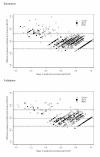Mapping of the EQ-5D index from clinical outcome measures and demographic variables in patients with coronary heart disease
- PMID: 20525323
- PMCID: PMC2900231
- DOI: 10.1186/1477-7525-8-54
Mapping of the EQ-5D index from clinical outcome measures and demographic variables in patients with coronary heart disease
Abstract
Background: The EuroQoL 5D (EQ-5D) is a questionnaire that provides a measure of utility for cost-effectiveness analysis. The EQ-5D has been widely used in many patient groups, including those with coronary heart disease. Studies often require patients to complete many questionnaires and the EQ-5D may not be gathered. This study aimed to assess whether demographic and clinical outcome variables, including scores from a disease specific measure, the Seattle Angina Questionnaire (SAQ), could be used to predict, or map, the EQ-5D index value where it is not available.
Methods: Patient-level data from 5 studies of cardiac interventions were used. The data were split into two groups - approximately 60% of the data were used as an estimation dataset for building models, and 40% were used as a validation dataset. Forward ordinary least squares linear regression methods and measures of prediction error were used to build a model to map to the EQ-5D index. Age, sex, a proxy measure of disease stage, Canadian Cardiovascular Society (CCS) angina severity class, treadmill exercise time (ETT) and scales of the SAQ were examined.
Results: The exertional capacity (ECS), disease perception (DPS) and anginal frequency scales (AFS) of the SAQ were the strongest predictors of the EQ-5D index and gave the smallest root mean square errors. A final model was chosen with age, gender, disease stage and the ECS, DPS and AFS scales of the SAQ. ETT and CCS did not improve prediction in the presence of the SAQ scales. Bland-Altman agreement between predicted and observed EQ-5D index values was reasonable for values greater than 0.4, but below this level predicted values were higher than observed. The 95% limits of agreement were wide (-0.34, 0.33).
Conclusions: Mapping of the EQ-5D index in cardiac patients from demographics and commonly measured cardiac outcome variables is possible; however, prediction for values of the EQ-5D index below 0.4 was not accurate. The newly designed 5-level version of the EQ-5D with its increased ability to discriminate health states may improve prediction of EQ-5D index values.
Figures


Similar articles
-
Relationship between the EQ-5D index and measures of clinical outcomes in selected studies of cardiovascular interventions.Health Qual Life Outcomes. 2009 Nov 26;7:96. doi: 10.1186/1477-7525-7-96. Health Qual Life Outcomes. 2009. PMID: 19941657 Free PMC article.
-
Predicting EQ-5D utility scores from the Seattle Angina Questionnaire in coronary artery disease: a mapping algorithm using a Bayesian framework.Med Decis Making. 2011 May-Jun;31(3):481-93. doi: 10.1177/0272989X10386800. Epub 2010 Dec 2. Med Decis Making. 2011. PMID: 21127316
-
Mapping ALSFRS-R and ALSUI to EQ-5D in Patients with Motor Neuron Disease.Value Health. 2018 Nov;21(11):1322-1329. doi: 10.1016/j.jval.2018.05.005. Epub 2018 Jul 26. Value Health. 2018. PMID: 30442280
-
A review of health utilities using the EQ-5D in studies of cardiovascular disease.Health Qual Life Outcomes. 2010 Jan 28;8:13. doi: 10.1186/1477-7525-8-13. Health Qual Life Outcomes. 2010. PMID: 20109189 Free PMC article. Review.
-
The minimum clinically important difference for EQ-5D index: a critical review.Expert Rev Pharmacoecon Outcomes Res. 2014 Apr;14(2):221-33. doi: 10.1586/14737167.2014.894462. Expert Rev Pharmacoecon Outcomes Res. 2014. PMID: 24625040 Review.
Cited by
-
Predicting the EQ-5D utilities from the Kansas City Cardiomyopathy Questionnaire in patients with heart failure.Eur Heart J Qual Care Clin Outcomes. 2021 Jul 21;7(4):388-396. doi: 10.1093/ehjqcco/qcab014. Eur Heart J Qual Care Clin Outcomes. 2021. PMID: 33724402 Free PMC article.
-
Psychosocial factors, mental health, and coordination capacity in patients with heart failure with preserved ejection fraction compared with heart failure with reduced ejection fraction.ESC Heart Fail. 2021 Aug;8(4):3268-3278. doi: 10.1002/ehf2.13468. Epub 2021 Jun 13. ESC Heart Fail. 2021. PMID: 34121363 Free PMC article.
-
The cost-effectiveness of a uniform versus age-based threshold for one-off screening for prevention of cardiovascular disease.Eur J Health Econ. 2023 Sep;24(7):1033-1045. doi: 10.1007/s10198-022-01533-y. Epub 2022 Oct 14. Eur J Health Econ. 2023. PMID: 36239877
-
Review of Systematic Reviews in the Field of Telemedicine.Med J Islam Repub Iran. 2021 Dec 29;35:184. doi: 10.47176/mjiri.35.184. eCollection 2021. Med J Islam Repub Iran. 2021. PMID: 36042824 Free PMC article.
-
Mapping the Seattle Angina Questionnaire to EQ-5D-5L in patients with coronary heart disease.Health Qual Life Outcomes. 2023 Jul 3;21(1):64. doi: 10.1186/s12955-023-02151-9. Health Qual Life Outcomes. 2023. PMID: 37400827 Free PMC article.
References
-
- The EQ-5D website. http://www.euroqol.org/
-
- Guide to the methods of technology appraisal, National Institute for Health and Clinical Excellence website. http://www.nice.org.uk/niceMedia/pdf/TAP_Methods.pdf - PubMed
-
- Campbell HE, Tait S, Buxton MJ, Sharples LD, Caine N, Schofield PM, Wallwork J. A UK trial-based cost--utility analysis of transmyocardial laser revascularization compared to continued medical therapy for treatment of refractory angina pectoris. Eur J Cardiothorac Surg. 2001;20:312–318. doi: 10.1016/S1010-7940(01)00801-6. - DOI - PubMed
Publication types
MeSH terms
Grants and funding
LinkOut - more resources
Full Text Sources
Medical

